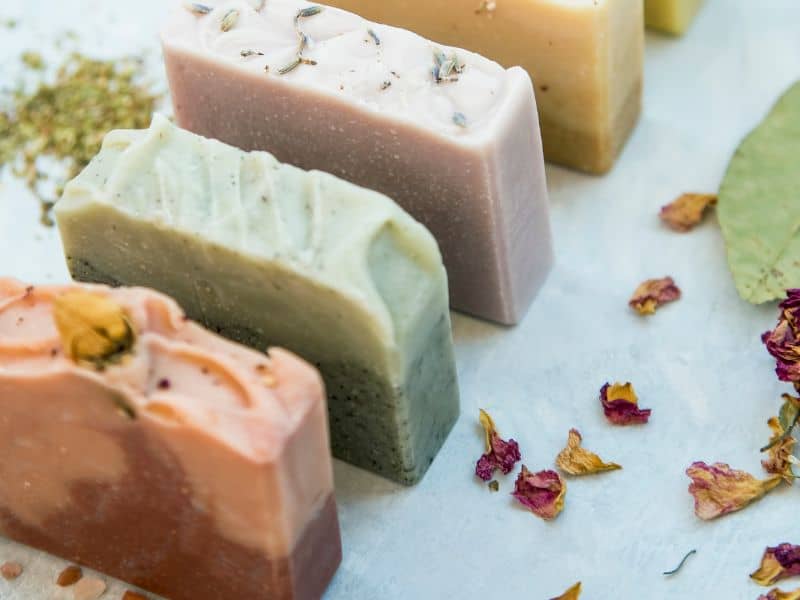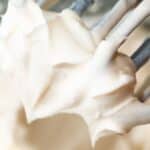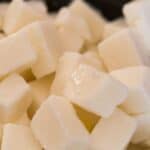One of the best parts about melt and pour soap is the customization possibilities without all of the work required in other soap making techniques. You can take your melt and pour soap creations to the next level by using a variety of additives to enhance the appearance and benefits of your soap. But, what can you add to melt and pour soap?
You can add various additives to melt and pour soap, such as exfoliants, herbs, essential oils, fragrance oils, natural colorants, glitter and mica, and milk. These additives can provide different benefits and create unique soap creations.
Melt and pour soap provides so many possibilities when it comes to additives and customization helping feed its popularity today. Let’s take a closer look at some of the possibilities.
Melt and Pour Soap Additives
Exfoliants
Exfoliants provide melt and pour soap a gentle scrubbing action that can help remove dead skin cells and promote smoother, softer skin.
Some examples of exfoliants that you can use in melt and pour soap include:
- Sugar
- Salt
- Ground coffee
- Oatmeal
- Poppy seeds
When using exfoliants in melt and pour soap, it’s important to choose an appropriate amount that won’t make the soap too scratchy or rough on the skin.
Exfoliants can add a natural texture and visual interest to your soap, making it a popular choice for those who want a little extra exfoliation in their skincare routine.
Essential Oils
When added to melt and pour soap, essential oils can provide a natural fragrance and also offer a range of benefits depending on the oil you choose.
Here are some popular essential oils for melt and pour soap:
- Lavender: Calming and soothing, lavender essential oil is a popular choice for melt and pour soap. It has a floral scent that can help promote relaxation and reduce stress.
- Tea Tree: Known for its antibacterial and antifungal properties, tea tree essential oil can help treat acne and other skin conditions. It has a fresh, medicinal scent that can be invigorating.
- Peppermint: Refreshing and cooling, peppermint essential oil can provide a tingling sensation on the skin. It’s also believed to help improve circulation and relieve muscle tension.
- Eucalyptus: Known for its respiratory benefits, eucalyptus essential oil can provide a refreshing and invigorating scent. It can also help soothe sore muscles and promote relaxation.
- Lemongrass: Citrusy and uplifting, lemongrass essential oil can provide a refreshing and energizing scent. It’s also believed to have antimicrobial properties that can help cleanse the skin.
- Sweet Orange: With a bright and uplifting scent, sweet orange essential oil can help promote a positive mood and reduce stress. It’s also believed to have antibacterial and antifungal properties that can help treat acne and other skin conditions.
- Rosemary: With an earthy and herbaceous scent, rosemary essential oil can help stimulate the senses and promote mental clarity. It’s also believed to have antimicrobial properties that can help cleanse the skin.
It’s important to note that they are highly concentrated and should be used sparingly. Generally, you should add about 0.5-3% essential oil to your soap base. Also, make sure to choose essential oils that are safe for skin use and are appropriate for the age group you are making the soap for.
Fragrance Oils
Fragrance oils are synthetic or natural blends of aroma compounds that are used to add scent to melt and pour soap. They come in a wide variety of scents, from floral to fruity to spicy. Fragrance oils are often used in soap making because they have a more consistent and long-lasting scent compared to essential oils.
Here are some popular fragrance oils for melt and pour soap:
- Vanilla: Sweet and warm, vanilla fragrance oil is a popular choice for melt and pour soap. It can add a comforting and cozy scent to your soap.
- Coconut: With a tropical and refreshing scent, coconut fragrance oil can provide a beachy and summery vibe to your soap. It’s a popular choice for those who want a fresh and tropical scent.
- Jasmine: With a sweet and floral scent, jasmine fragrance oil can add a romantic and feminine touch to your soap. It’s a popular choice for those who want a more luxurious and indulgent scent.
- Peppermint: Refreshing and cooling, peppermint fragrance oil can provide a tingling sensation on the skin. It’s a popular choice for those who want a more invigorating and refreshing scent.
- Citrus: With a bright and uplifting scent, citrus fragrance oils such as lemon, orange, and grapefruit can help promote a positive mood and reduce stress. They’re popular choices for those who want a fresh and zesty scent.
- Lavender: Calming and soothing, lavender fragrance oil is a popular choice for melt and pour soap. It has a floral scent that can help promote relaxation and reduce stress.
- Cinnamon: Warm and spicy, cinnamon fragrance oil can add a cozy and comforting scent to your soap. It’s a popular choice for those who want a more autumnal and festive scent.
When using fragrance oils in melt and pour soap, it’s important to choose a high-quality oil that is specifically formulated for soap making. Some fragrance oils may discolor, so it’s important to test a small amount before adding it to your entire batch.
Natural Colorants
If you want to add color to your melt and pour soap without using synthetic dyes, natural colorants are a great option. Some examples of natural colorants include clays, spices, and botanicals. These ingredients can provide a range of colors from earthy browns to vibrant reds and purples.
When using natural colorants, it’s important to remember that they may not be as strong as synthetic dyes and may produce more muted or subtle colors. Also, some natural colorants may have a slight scent that can affect the fragrance of your soap.
Glitter and Mica
If you want to add some sparkle to your melt and pour soap, you can use glitter or mica. These additives can provide a range of shimmer and shine to your soap, and come in a variety of colors and sizes. Glitter and mica are often used in soap making for special occasions like weddings or holidays.
When using glitter or mica in melt and pour soap, it’s important to choose a cosmetic grade that is safe for skin use. Also, make sure to use a small amount as too much can make the soap gritty or scratchy.
Milk
Milk is another additive that you can use in melt and pour soap to add some extra nourishment and moisturization to your soap. You can use a variety of milks, such as cow’s milk, goat’s milk, or coconut milk.
Milk can provide a creamy texture and can be beneficial for dry or sensitive skin.
When using milk in melt and pour soap, it’s important to add it slowly to your soap base and to mix well. Milk can also cause your soap to discolor, so you may want to test a small amount before adding it to your entire batch.
Embeds
Embedding is a technique that involves adding small objects or shapes into the melt and pour soap to create a visually interesting soap with added texture and dimension. Embedding can be used to enhance melt and pour soap in a variety of ways. For example, you can embed dried flowers or herbs to create a natural and organic soap with added aromatherapy benefits.
You can also embed soap curls or embeds to add color and texture to your soap. Additionally, you can embed toys or trinkets for kids’ soaps, or embeds with personalized messages for gifts or special occasions. Embedding is a versatile technique that allows for endless creativity and customization in melt and pour soap making.
Frequently Asked Questions
Some common exfoliants that can be added to melt and pour soap include oatmeal, ground coffee, pumice, poppy seeds, and sea salt.
Fresh herbs are not recommended in melt and pour soap as they can create mold and bacteria growth. Instead, you can use dried herbs or herbal powders.
The recommended amount of essential oil to add to melt and pour soap is typically 1-3% of the total weight of the soap base. It is important to check the recommended usage rates for each individual essential oil as some may require less or more.
While food coloring can be used to color melt and pour soap, it is not recommended as it can bleed or fade over time. It is recommended to use soap-specific colorants, such as mica or liquid soap dye, for best results.
Conclusion
In conclusion, when making melt and pour soap you can add a variety of additives, such as exfoliants, herbs, essential oils, fragrance oils, natural colorants, glitter and mica, and milk, soap makers can create unique soap formulations with added benefits. Additionally, techniques such as layering, swirling, embedding, stamping, and shaping can enhance the appearance of soap creations, further fueling creativity.
In addition, it is okay to experiment with different combinations of additives and techniques that can lead to unexpected and exciting results. So don’t be afraid to have fun with your melt and pour soap creations, and let your creativity shine!






